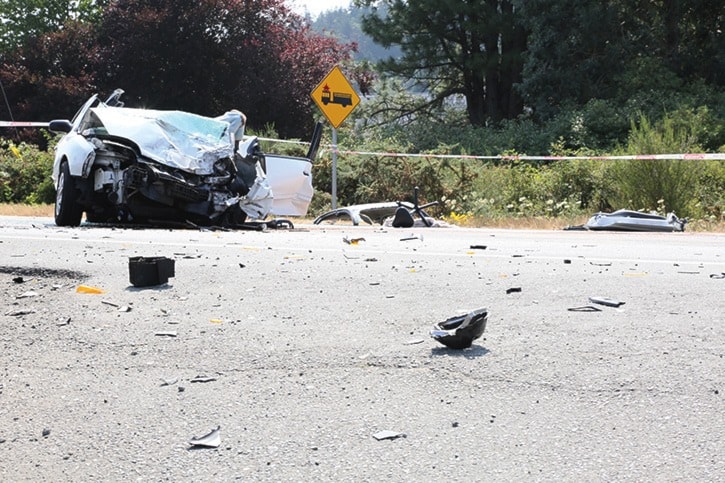There were 477 car crashes in Langford in 2013, which is the most recent set of data available for the Insurance Corporation of British Columbia’s (ICBC) crash map statistics. In Colwood there were 189 for the same year, 149 in View Royal and 20 each in Metchosin and the Highlands. Those figures exclude crashes in parking lots and incidents involving parked vehicles. They also do not include crashes on the Malahat outside of the Langford border.
Of those crashes, there were 269 in Langford, 115 in Colwood, 81 in View Royal and 15 each in Metchosin and the Highlands that were property damage only and did not result in any injury claims.
Since data is not available for this year or 2014 it is hard to compare the West Shore with the rest of the province but ICBC is reporting that province-wide they are seeing the number of crashes remain constant. However, they are seeing the number of injury claims skyrocket in recent months.
Those injury claims are “a lot more costly than repairing a vehicle,” said Adam Grossman, a senior media relations advisor for ICBC.
 Last week ICBC proposed a potential 6.7 per cent rate hike for basic insurance. This announcement was met with an onslaught of objections from members of the public and some government officials. Transportation Minister Todd Stone even said the maximum 6.7 per cent increase was too much.
Last week ICBC proposed a potential 6.7 per cent rate hike for basic insurance. This announcement was met with an onslaught of objections from members of the public and some government officials. Transportation Minister Todd Stone even said the maximum 6.7 per cent increase was too much.
This year’s increase cannot be more than 1.5 per cent of the previous year’s increase and has to be between 3.7 and 6.7 per cent because of a rate smoothing policy introduced by the province in 2013.
“The actual costs of injury claims have been going up over the years.” But Grossman said until recently, the number of injuries being reported had remained relatively flat.
That rapid escalation in the number of injury claims being reported has been attributed to causing some of the demand for the maximum increase. The cost of ICBC’s bodily injury claims, which include pain and suffering, future care and loss of wages, are expected to hit $2.3 billion this year. That’s an increase of 64 per cent since 2008. This year alone, they are up 10 per cent compared to last.
“We’re seeing more and more.” Grossman said they are especially seeing “more claims for relatively minor soft tissue injuries.”
While he admitted that some soft tissue injuries can result in prolonged pain and can be difficult to treat, he said it wasn’t a rise in the severity of soft tissue injuries but simply a rise in the number being reported.
Also suspected to be a cause of the growing number of claims reported is “an increase in potentially exaggerated or fraudulent claims,” Grossman said. On average he said in Canada studies suggest that 10 to 20 per cent of all claims have some element of fraud. Which is why he said ICBC is investing in and expanding their fraud detection program.
“That’s something we’re really looking at,” he said.
ICBC also attributes factors such as higher legal and medical costs, more represented claims and more complex/catastrophic claims contributing to the jump.
The corporation has until Oct. 30 to file a formal rate application with the B.C. Utilities Commission. If regulators approve the request it will be the fourth consecutive year of basic insurance premium increases, which saw increases of 11.2 per cent in 2012 and 5.2 per cent in 2013 and 2014.
ICBC president and CEO Mark Blucher has pledged to work with the government to find ways to reduce the initial calculations that suggested the maximum 6.7 per cent increase would be required.
Watch speed limits
In B.C., according to ICBC, 78 children between the ages of five to 18 are injured in crashes in school or playground zones every year. That number includes the on average 12 children that are injured on Vancouver Island every year.
While the statistic don’t break down into municipality, it still is an alarming number of children that are hurt every year.
With school now back in session, the B.C. government, ICBC, and police are reminding drivers to watch for children and expect more traffic on the roads. They are also reminding drivers that school zones are now in effect, unless otherwise posted, with a 30 km/h speed limit from 8 a.m. to 5 p.m. Playground zones are in effect every day of the year from dawn till dusk.
Tips and reminders for drivers:
-When dropping children off in school zones, allow them to exit the car from the side closest to the sidewalk.
-Never allow a child to cross mid-block.
-If a vehicle in front of or beside you is stopped, they may be yielding to a pedestrian, prepare to stop and proceed with caution.
-Vehicles approaching from both directions must stop for school buses when their lights are flashing.
-Before entering your vehicle make sure no small children are hidden from your view and always look for pedestrians when backing up.
katie@goldstreamgazette.com
